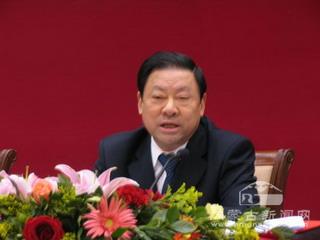Source: Inner Mongolia News
07-19-2007 10:44
 |
| The region's Party secretary Chu Bo |
A thriving Inner Mongolia Autonomous Region bears a testimony to the success of the country's policy of autonomy for minorities, the region's Party secretary Chu Bo told a group of Hong Kong and Macao journalists.
Chu was speaking on Wednesday to a visiting delegation of journalists from the two SARs, which is led by Ta Kung Pao's editor-in-chief Zhou Qing.
The region's robust economic development, Chu explained, has been a result of its adherence to the principle of scientific development in theory and in practice, its commitment to building a harmonious society, its concern for people's livelihood, as well as the country's strategy to develop the West.
Chu pointed out that the central government has always been concerned about the region's development.
As early as 1950s, the then premier Zhou Enlai called Inner Mongolia "amodel autonomous region".
In 1978, Deng Xiaoping said that Inner Mongolia, with the extensive steppes and a small population, may in future see itself in the forefront.
In 1999, the then President Jiang Zemin, when making a tour through Inner Mongolia, expressed hope that the region could leverage on its resource advantage and translate it into economic progress, turning itself into the country's another growth engine in the coming century.
When he inspected the region in 2003, President Hu Jintao said that a well-governed Inner Mongolia had far-reaching implications not only for the more than 23 million people who lived there but also for the general scheme of the party and the country.
Thanks to the central government's concern and support, Inner Mongolia has undergone tremendous advancement in terms of economic and social development.
The region's GDP surged from 150 billion yuan in 2000 to 47.9 billion yuan in 2006, a 196-times leap compared to the 537 million yuan in 1947. Per capita GDP skyrocketed from 96 yuan in 1947 to 20,047 yuan (US$2,513) in 2006, and may reach US$3,000 this year, ranking among the first ten in the country.
The fixed asset investment in the region exceeded 700 billion yuan over the past six years.
This year, Inner Mongolia will focus on some of its unique industries and promote industrial diversity, expansion, enhancement and modernization.
In 2006, industrial value-added in the region reached 197.8 billion yuan, constituting 41.3 per cent of GDP, compared to only 6.9 per cent in 1947.
Currently, coal production amounts to 291 million tons, electricity output 141.64 billion Megawatt-hours, and steel production 8.61 million tons.
Industrial structure continues to improve, while the value-added of the region's six pillar industries - energy, metallurgy, chemical industry, processing of agricultural produce, equipment manufacturing and high technology - make up 85 per cent of the industrial value-added at or above regional level. These six industries have become the main growth engines that are driving the local economy .
Inner Mongolia now boasts 17 brandnames, like Erdos, Mengniu and Yili, that have become popular across the country. As many as seven enterprises are enjoying a total revenue of over10 billion yuan each.
The region's government has also launched a number of measures that aimed to give the service industry a shot in the arm. The idea is to reform the traditional service industries and at the same time develop modern ones.
While developing its economy, Inner Mongolia, Chu stressed, has not neglected its natural environment. Environmental protection is viewed as the principal infrastructure project because it does not only relate to the region's sustainable development, but also to the ecological well-being of thecapital city, northern China and even the country at large.
Environmental protection in Inner Mongolia has become all the more important after the country decided to develop its remote west. The region is set to turn itself into an ecological protective screen for the rest of the country.
In this connection, the Inner Mongolian government has been trying to widen vegetation cover to extensive areas in the region and enhance ecological resilience.
With the help of the country, the region has launched nine projects to protect its steppes and natural forests and tackle the source of sandstorms blasting Beijing and Tianjin for centuries.
The region is also taking steps to raise peasant incomes and relieve the poor, as well as undertaking ecological migrations.
All in all, advancing the economy, improving people's lives and protecting the environment are the recurring themes in Inner Mongolia'sdevelopment strategy, the party secretary concluded.
Editor:Chen Ge
